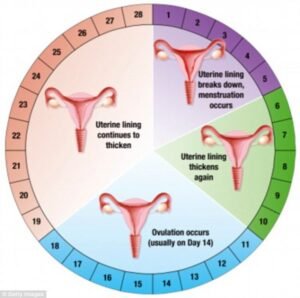Welcome to our detailed exploration of the 4 phases of the menstrual cycle. This guide will cover each phase, including a menstrual cycle diagram and insights into menstrual cycle days.
Table of Contents
- The Menstrual Phase
- The Follicular Phase
- The Ovulatory Phase
- The Luteal Phase
- Frequently Asked Questions
The 4 Phases Of The Menstrual Cycle

- Menstruation: This phase marks the beginning of the cycle and involves the shedding of the uterine lining. It usually lasts between 3 to 7 days. During this time, if there is no fertilized egg to implant in the uterus, the thickened lining (endometrium) is shed, leading to menstrual bleeding. This phase can be associated with symptoms like cramps, bloating, and mood swings.
- Follicular Phase: This phase begins on the first day of menstruation but overlaps with it for several days. It’s characterized by the growth and development of multiple follicles in the ovaries. Each follicle contains an immature egg. The most dominant follicle will eventually mature into an egg ready for ovulation. During this phase, the body increases the production of estrogen, which stimulates the lining of the uterus to thicken in preparation for a potential pregnancy.
- Ovulation: Typically occurring mid-cycle, ovulation is the release of a mature egg from the surface of the ovary. This phase is triggered by a surge in luteinizing hormone (LH). The egg then travels down the fallopian tube where it can be fertilized by sperm. Ovulation is often accompanied by various physical symptoms, such as a slight rise in basal body temperature and changes in cervical mucus.
- Luteal Phase: Following ovulation, the luteal phase begins. If the egg is fertilized, this phase supports the early stages of pregnancy. The ruptured follicle transforms into a structure called the corpus luteum, which secretes progesterone. This hormone is crucial in maintaining the thickened uterine lining, creating a supportive environment for a fertilized egg to implant and grow. If pregnancy does not occur, progesterone levels decrease, leading to the onset of menstruation and the start of a new cycle.
Frequently Asked Questions besides The 4 Phases Of The Menstrual Cycle
- What is the menstrual cycle? The menstrual cycle is a monthly series of changes a woman’s body goes through in preparation for the possibility of pregnancy. It includes the process of ovulation and menstruation.
- How long does a typical menstrual cycle last? A typical menstrual cycle lasts about 28 days, but it can vary from 21 to 35 days in adults and from 21 to 45 days in young teens.
- What is menstruation? Menstruation is the shedding of the uterine lining, resulting in bleeding from the vagina. It marks the beginning of the menstrual cycle.
- What happens during ovulation? Ovulation is the release of a mature egg from one of the ovaries. It usually occurs around the middle of the cycle and is the time when a woman is most fertile.
- What are common symptoms of menstruation? Common symptoms include abdominal cramps, bloating, breast tenderness, mood swings, and headaches.
- Is it normal to have irregular periods? Occasional irregular periods can be normal, especially during puberty and perimenopause. However, consistently irregular periods may need medical attention.
- Can you get pregnant during your period? While it’s less likely, it’s still possible to get pregnant during your period, especially if you have a shorter menstrual cycle.
- What is Premenstrual Syndrome (PMS)? PMS refers to a set of physical and emotional symptoms that occur one to two weeks before menstruation. Symptoms can include mood swings, tender breasts, food cravings, fatigue, irritability, and depression.
- What is the luteal phase? The luteal phase is the latter part of the menstrual cycle, starting after ovulation and lasting until the beginning of menstruation. It’s characterized by increased levels of progesterone.
- What are menstrual cycle disorders? Menstrual cycle disorders can include conditions like amenorrhea (absence of menstruation), dysmenorrhea (painful periods), menorrhagia (heavy menstrual bleeding), and irregular cycles. These conditions often require medical evaluation.
- How can menstrual cycle tracking be helpful? Tracking your menstrual cycle can help in understanding your body’s patterns, identifying any irregularities, and determining the best time for conception.
- What lifestyle factors can affect the menstrual cycle? Factors like stress, significant weight loss or gain, excessive exercise, and travel can affect the menstrual cycle. Hormonal imbalances and certain medical conditions can also have an impact.
check this out :
Your Way to Better Health In 6 Tips About Nuts : How Nuts Enhance Your Health and Wellbeing



